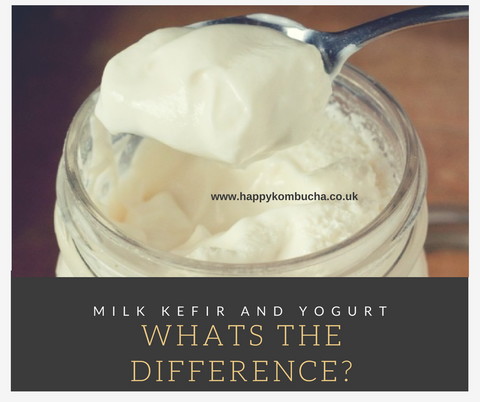
As kefir resembles yogurt, these two are usually compared. Many think that the two are similar but in reality, they have many differences. Both kefir and yogurt are cultured milk products but they contain different strains of micro-organisms. Yogurt contains two types of bacteria, Lactobacillus bulgaricus and Streptococcus thermophilus while kefir contains several other strains of bacteria not commonly found in yogurt: Lactobacillus, Leuconostoc, Acetobacter, Streptococcus and Pseudomonas species. Not only that, kefir also contains different strains of yeast like Candida, Kluyveromyces and Saccharomyces species. Another worth mentioning is that the beneficial bacteria contained in milk kefir can actually colonize the intestinal tract while those found in yogurt provide food for the healthy bacteria found in the gut, keeping our digestive tract clean.
Yogurt starters are both mesophilic and thermophilic, while milk kefir are mesophilic. Mesophlic means an organism thrives best in room temperature, neither too cold or too hot, around 20 and 45°C (68 and 113 °F). Thermophilics are heat-loving. They grow best at extremely hot temperature at around 45 and 122°C (113 and 252 °F). Activated recyclable yogurt starters are re-cultured by mixing a little of the previous batch into fresh milk. Once the new batch is done, it then becomes the starter for the next batch and so on. Another way of culturing is using the direct-set or single-use yogurt starters which come in powdered form. These are usually thermophilic and are only one-time use. Although this type of yogurt can sometimes be re-cultured a few more times, but eventually, a new set of starter will be required. On the other hand, milk kefir is cultured using milk kefir grains and requires transferring to a fresh batch of milk every 24-48 hours.
As all are familiar with the taste of yogurt, different varieties of yogurt starter yields yogurt that ranges from mild to tangy. The consistency ranges from a thin, liquid-like, pourable yogurt to a thicker, creamy type. Milk kefir can be a little yeasty due to the beneficial yeasts contained in the culture. It is also sourer as compared with yogurt. Both yogurt and kefir can be drained to produce cheese. Draining whey from yogurt or kefir makes thick yogurt or cheese ranging from soft to hard cheese. Both are versatile and can be used in many kitchen recipes, from appetizers, salad dressings, dips to desserts.
